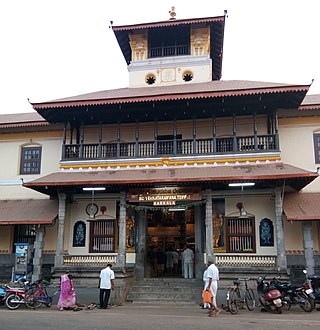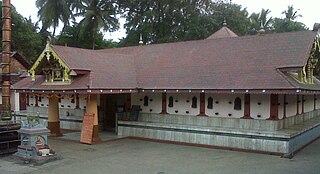
Sringeri also called Shringeri is a hill town and Taluk headquarters located in Chikkamagaluru district in the Indian state of Karnataka. It is the site of the first maṭha established by Adi Shankara, Hindu theologian and exponent of the Advaita Vedanta philosophy. Located on the banks of the river Tungā, the town draws a large number of pilgrims to its temples of Sri Sharadamba, Sri Vidyashankara, Sri Malahanikareshvara and other deities.
Kalady or Kaladi is a town located between Angamaly and Perumbavoor, east of the Periyar river, near to Malayattoor in Ernakulam district of Kerala, India, not far from Cochin International Airport. It is notable as the birthplace of 9th century Indian philosopher Adi Shankara.

The Vadakkumnathan Temple is an ancient Hindu temple dedicated to Shiva in Thrissur, in the Thrissur district of Kerala, India. The temple is a classical example of the architectural style of Kerala and has one monumental tower on each of the four sides in addition to a koothambalam. Mural paintings depicting various scenes from the Mahabharata can be seen inside the temple. The shrines and the Kuttambalam display vignettes carved in wood. The temple, along with the mural paintings, has been declared as a National Monument by India under the AMASR Act. According to popular local lore, this is the first temple built by Parashurama, the sixth avatar of Vishnu. Thekkinkadu Maidan, encircling the Vadakkumnathan Temple, is the main venue of the renowned Thrissur Pooram festival.

Kollur Mookambika Temple is located at Kollur in Byndoor Taluk of Udupi District in the region of Tulunadu and in the state of Karnataka, India. It is a Hindu temple dedicated to the mother goddess Mookambika.

A shaligram, or shaligrama shila, is a fossilized stone or ammonite collected from the riverbed or banks of the Kali Gandaki, a tributary of the Gandaki River in Nepal. It is also considered a form of Vishnu within Hinduism. The Kali Gandaki river flows through sacred places such as Muktinath and Damodar Kunda, enhancing the spiritual significance of these shaligrams.
The Maha Ganapathi Mahammaya Temple is a Hindu temple in Shirali in the Uttar Kannada district of Karnataka state. The temple is dedicated to the god Ganesha as Mahaganapati and the goddess Mahamaya (Shantadurga). The temple is the Kuladevata Temple of the Goud Saraswat Brahmin community. The temple god is a Kuladevata of the Kamaths, Bhats, Puraniks, Prabhus, Joishys, Mallyas, Kudvas and Nayak families from the Goud Saraswat Brahmin community. The Temple was built about 400 years ago. It was renovated in 1904.

Subramanya is a village located in Kadaba Taluk in Dakshina Kannada, India. The Kukke Subrahmanya Temple is located here. It is about 105 kilometres (65 mi) from Mangalore, connected by train and road. It was originally named "Kukke Pattana".

Sri Sharadamba Temple is a famous Hindu temple dedicated to goddess Sharadamba in the holy town of Sringeri in Karnataka, India.
Saligrama is a town on NH 66 in Brahmavara taluk of Udupi district in the Indian state of Karnataka. It is located between Kundapura and Brahmavar. It is 24 km north of Udupi and 81 km from Mangalore.

The Vilwadrinatha Temple is a Hindu temple in Thiruvilwamala, a town in the city of Thrissur, Kerala, India. The principal deities are Rama, the seventh incarnation of the god Vishnu, and his brother, Lakshmana. It figures among the Abhimana Kshetrams in Vaishnavite traditions. This is one of the four major Rama temples in Kerala — the other three are in Thriprayar, Kadavallur, and Thiruvangad. The temple houses an idol of Lakshmana, which is rare in India. Vilwadrinatha Temple is located in the centre of the community of Thiruvilwamala, atop a 100-foot-high hillock. Visible from the temple is Bharathappuzha, the second-largest river in Kerala, which flows past the temple's northern side from around 3 kilometres away.
Hattiangadi is a village in Kundapura taluk of Udupi district. The village is famous for the Shree Siddi Vinayaka temple dedicated to the God Ganesha.

Samvedis or Samvedi Brahmins are an Indian Hindu Brahmin community, originating from a group of classical musicians and classical dancers. They follow Sama Veda and believed to have been originated from Odisha, India.

Banalinga, a stone found in nature, in the bed of the Narmada River in Madhya Pradesh state, India, is an iconic symbol of worship, based on either the scriptures or cultural traditions among the Hindus, particularly of the Shaivas and Smarta Brahmins. It is a smooth ellipsoid stone that represents a lingam, an anionic form of the deity Shiva.

Sapta Badri constitutes a group of seven sacred Hindu temples, dedicated to god Vishnu, located in Garhwal Himalayas in the Indian state of Uttarakhand. The Badrinath temple, called the Badri Vishal is the primary temple among the seven shrines. The other six being Adi Badri, Bhavishya Badri, Yogadhayan Badri, Vriddha Badri, Ardha Badri and Dhyan Badri. The Panch Badri temple circuit consisted of only five temples, omitting Ardha Badri and usually Dhyan Badri. Rarely, Narasingh Badri, is included in the Sapta Badri or Panch Badri list.

Sri Venkataramana Temple, Karkala, also known as Padutirupathi, is a temple in Karnataka, India. It was built by Goud Saraswat Brahmins of Karkala and was installed on 25 April 1537.
Narasimha Temple is situated in Puri, Odisha, India, to the western side of Gundicha Temple and to the east of the Indradyumna tank.
Southadka is a pilgrimage centre in Dakshina Kannada district in the Indian state of Karnataka. It is located 3 km from Kokkada in Belthangady Taluk.

Sri Lakshmi Narasimha Temple is a Hindu temple associated with Gowda Saraswatha Brahmins (GSB) in and around Thalassery.
Vishaka Sri Sarada Peetham, also called the Sarada Peetham is a Hindu institution, located in Chinnamushidiwada, Visakhapatnam, Andhra Pradesh. It's dedicated to goddess Raja Shyamala Devi and Sri Sharada.
The Yogananda Lakshmi Narasimha Swamy Temple, also known as Mattapalli Narasimha Temple, is a Hindu temple dedicated to Narasimha, the half-man half-lion avatar of Vishnu, and his consort Lakshmi. It is located in Mattampally, a village in the Mattampally mandal of Suryapet district in the Indian state of Telangana. One of the Pancha Narasimha Kshetras, the temple is located on the banks of the Krishna River, and was built in the 11th century by Anumala Machi Reddy, the king of Thangedu region after the deity appeared in his dream and instructed him to do so. The main shrine houses a swayambhu (self-manifested) idol of Narasimha as Yogananda Lakshmi Narasimha, and was worshipped by sage Bharadvaja and other seers for hundreds of years before the temple was constructed. Lakshmi is worshipped here as Rajalakshmi Thayar and Chenchu Lakshmi Thayar.












